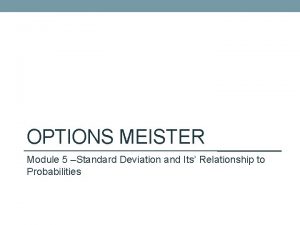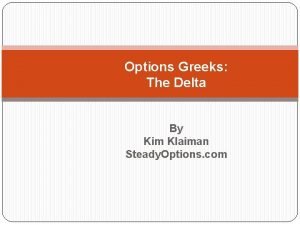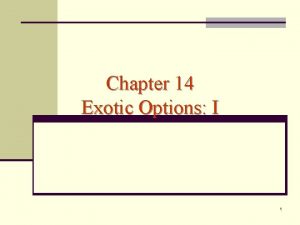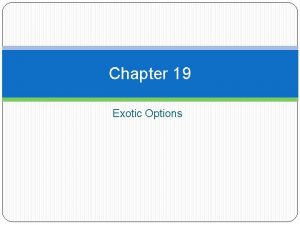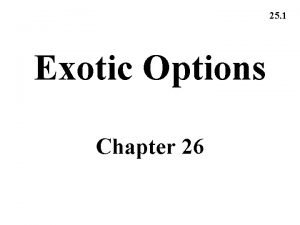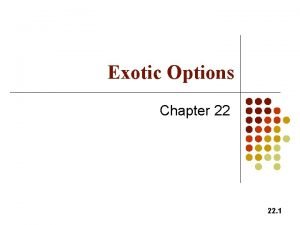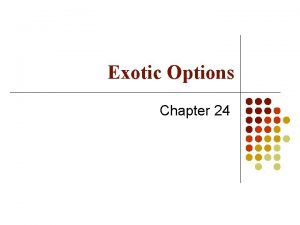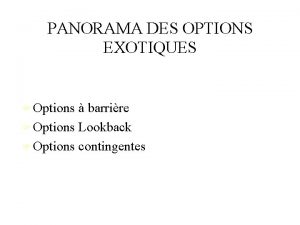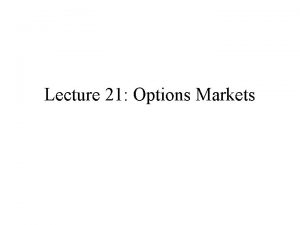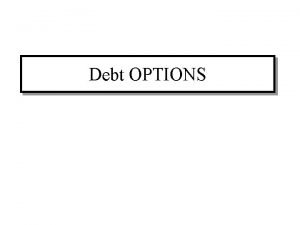Chapter 14 Exotic Options I Exotic Options Nonstandard






















- Slides: 22

Chapter 14 Exotic Options: I

Exotic Options • Nonstandard options • Exotic options solve particular business problems that an ordinary option do not • They are often constructed by tweaking ordinary options in minor ways © 2013 Pearson Education, Inc. , publishing as Prentice Hall. All rights reserved. 14 -2

Exotic Options (cont’d) • Relevant questions – How does the exotic payoff compare to that of a standard option? – Can the exotic option be approximated by a portfolio of other options? – Is the exotic option cheap or expensive relative to standard options? – What is the rationale for the use of the exotic option? – How easily can the exotic option be hedged? © 2013 Pearson Education, Inc. , publishing as Prentice Hall. All rights reserved. 14 -3

Asian Options • The payoff of an Asian option is based on the average price over some period of time – path-dependent • Situations when Asian options are useful – When a business cares about the average exchange rate over time – When a single price at a point in time might be subject to manipulation – When price swings are frequent due to thin markets © 2013 Pearson Education, Inc. , publishing as Prentice Hall. All rights reserved. 14 -4

Asian Options (cont’d) • Example – The exercise of the conversion option in convertible bonds is based on the stock price over a 20 -day period at the end of the bond’s life • Asian options are less valuable than otherwise equivalent ordinary options, since the average price of the underlying asset is less volatile than the asset price itself © 2013 Pearson Education, Inc. , publishing as Prentice Hall. All rights reserved. 14 -5

Asian Options (cont’d) • There are eight (23) basic kinds of Asian options: – Put or call – Geometric or arithmetic average – Average asset price is used in place of underlying price or the strike price • Arithmetic versus geometric average: – Suppose we record the stock price every h periods from t = 0 to t = T – Arithmetic average: Geometric average: © 2013 Pearson Education, Inc. , publishing as Prentice Hall. All rights reserved. 14 -6

Asian Options (cont’d) • Average used as the asset price: Average price option – Geometric average price call = max [0, G(T) – K] – Geometric average price put = max [0, K – G(T)] • Average used as the strike price: Average strike option – Geometric average strike call = max [0, ST – G(T)] – Geometric average strike put = max [0, G(T) – ST] © 2013 Pearson Education, Inc. , publishing as Prentice Hall. All rights reserved. 14 -7

Asian Options (cont’d) • All four options above could also be computed using arithmetic average instead of geometric average • Relatively simple pricing formulas exist for pricing European options on the geometric average but not for arithmetic average options © 2013 Pearson Education, Inc. , publishing as Prentice Hall. All rights reserved. 14 -8

Asian Options (cont’d) • Comparing Asian options © 2013 Pearson Education, Inc. , publishing as Prentice Hall. All rights reserved. 14 -9

Asian Options (cont’d) • XYZ’s hedging problem – XYZ has monthly revenue of 100 m, and costs in dollars – xt is the dollar price of a euro at time t – In one year, the converted amount in dollars is – If we ignore interest, what we are trying to hedge is © 2013 Pearson Education, Inc. , publishing as Prentice Hall. All rights reserved. 14 -10

Asian Options (cont’d) • A solution for XYZ – An Asian put option that puts a floor K, on the average exchange rate received. The per euro payoff of this option would be © 2013 Pearson Education, Inc. , publishing as Prentice Hall. All rights reserved. 14 -11

Asian Options (cont’d) • Alternative solutions for XYZ’s hedging problem © 2013 Pearson Education, Inc. , publishing as Prentice Hall. All rights reserved. 14 -12

Barrier Options • The payoff depends on whether over the option life the underlying price reaches a specified level, called the barrier – Path-dependent – Since barrier puts and calls never pay more than standard puts and calls, they are no more expensive than standard puts and calls – Widely used in practice © 2013 Pearson Education, Inc. , publishing as Prentice Hall. All rights reserved. 14 -13

Barrier Options (cont’d) • Barrier puts and calls – Knock-out options: go out of existence (are “knocked-out”) • down-and-out: if the asset price falls to reach the barrier • up-and-out: if the asset price rises to reach the barrier – Knock-in options: come into existence (are “knocked-in”) • down-and-in: if the asset price falls to reach the barrier • up-and-in: if the asset price rises to reach the barrier – The important parity relation for barrier options is – Rebate options: make a fixed payment if the asset price reaches the barrier • down rebates: if the asset price falls to reach the barrier • up rebates: if the asset price rises to reach the barrier © 2013 Pearson Education, Inc. , publishing as Prentice Hall. All rights reserved. 14 -14

Barrier Options (cont’d) © 2013 Pearson Education, Inc. , publishing as Prentice Hall. All rights reserved. 14 -15

Barrier Options (cont’d) © 2013 Pearson Education, Inc. , publishing as Prentice Hall. All rights reserved. 14 -16

Compound Options • An option to buy an option © 2013 Pearson Education, Inc. , publishing as Prentice Hall. All rights reserved. 14 -17

Gap Options • A gap call option pays S – K 1 when S > K 2 • The value of a gap call is where and © 2013 Pearson Education, Inc. , publishing as Prentice Hall. All rights reserved. 14 -18

Gap Options (cont’d) © 2013 Pearson Education, Inc. , publishing as Prentice Hall. All rights reserved. 14 -19

Gap Options (cont’d) © 2013 Pearson Education, Inc. , publishing as Prentice Hall. All rights reserved. 14 -20

Gap Options (cont’d) © 2013 Pearson Education, Inc. , publishing as Prentice Hall. All rights reserved. 14 -21

Exchange Options • Pays off only if the underlying asset outperforms some other asset (benchmark) outperformance option • The value of a European exchange call is where , and © 2013 Pearson Education, Inc. , publishing as Prentice Hall. All rights reserved. 14 -22
 Cell potential under nonstandard conditions
Cell potential under nonstandard conditions Non standard english examples ks2
Non standard english examples ks2 Static hedging of exotic options
Static hedging of exotic options Exotic species definition biology
Exotic species definition biology Nuclear pasta
Nuclear pasta Two exotic breeds of rabbits
Two exotic breeds of rabbits Exotic beam summer school
Exotic beam summer school Interference competition
Interference competition Woman walking in an exotic forest
Woman walking in an exotic forest B
B Exotic species definition
Exotic species definition Exotic species definition
Exotic species definition Exotic species definition
Exotic species definition Is the colorado river an exotic stream
Is the colorado river an exotic stream Audi r8 rental houston
Audi r8 rental houston Romsnticism
Romsnticism Chapter 3 food service career options worksheet answers
Chapter 3 food service career options worksheet answers What sort of evidence was used to arrest accused witches
What sort of evidence was used to arrest accused witches Systems analysis and design in an age of options pdf
Systems analysis and design in an age of options pdf Organisational socialisation
Organisational socialisation Option stock
Option stock Standard deviation options
Standard deviation options Steadyoptions review
Steadyoptions review





















